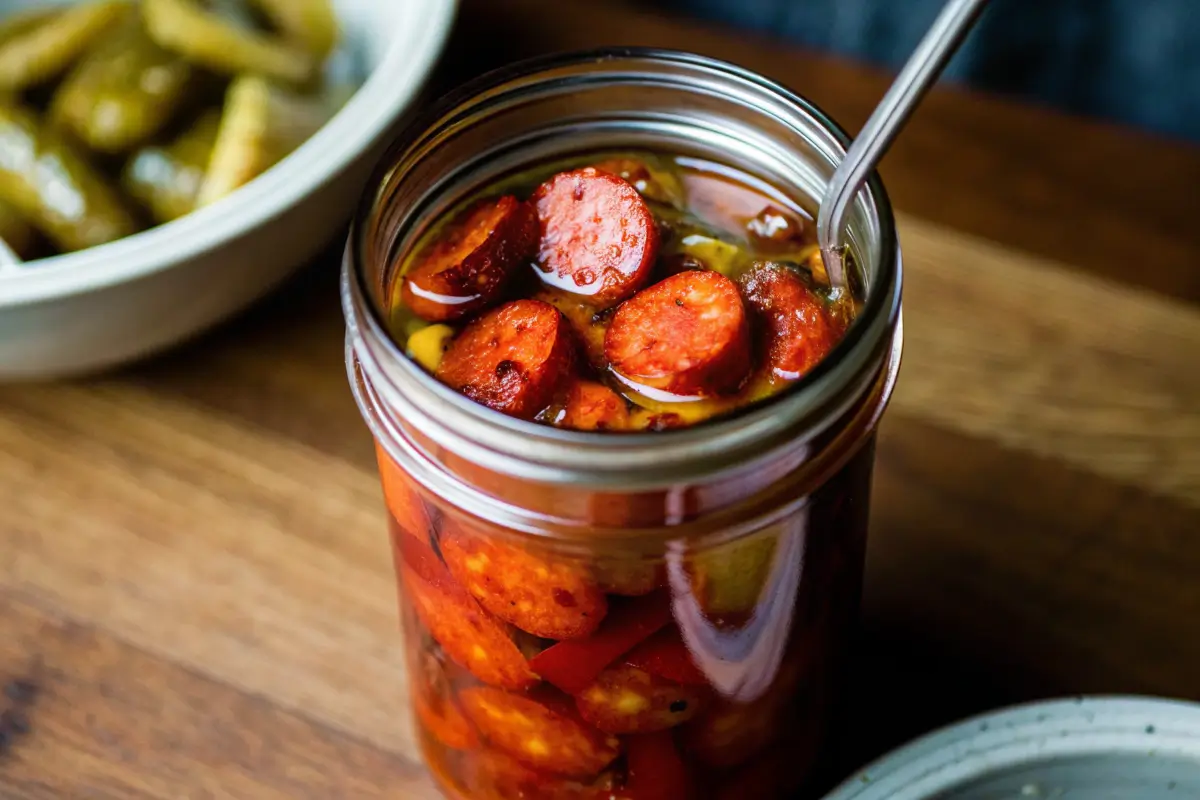Reading time: 9 minutes
Pickled sausages are a popular snack enjoyed by many, but are they actually good for you? These tangy, flavorful treats are often found in convenience stores or served as bar snacks, but their healthiness is often debated. In this article, we’ll take a closer look at what makes up a pickled sausage, its nutritional value, and whether it can fit into a healthy lifestyle. By the end, you’ll have a clear understanding of the benefits and drawbacks of this unique food.
Table of contents
- What Are Pickled Sausages Made Of? Ingredients and Their Health Implications
- The Pros and Cons of Eating Pickled Sausages Regularly
- How Do Pickled Sausages Compare to Other Pickled Foods?
- Are Pickled Sausages a Good Source of Protein?
- The Role of Sodium in Pickled Sausages: Is It Too High?
- Can Pickled Sausages Be Part of a Balanced Diet?
- The Impact of Pickled Sausages on Gut Health
- Are There Any Health Benefits to Eating Pickled Sausages?
- How to Choose the Healthiest Pickled Sausages at the Store
- Are Homemade Pickled Sausages Healthier Than Store-Bought Versions?
- The Potential Risks of Consuming Pickled Sausages Excessively
- How to Incorporate Pickled Sausages into a Healthy Meal Plan
- Are Pickled Sausages Safe for People with Dietary Restrictions?
- Conclusion
- FAQs
What Are Pickled Sausages Made Of? Ingredients and Their Health Implications
Pickled sausages are made by preserving sausages in a brine solution, which typically includes vinegar, salt, and spices. The sausages themselves are usually made from a mix of meats, though the exact ingredients can vary. Here’s a breakdown of the common components:
- Meat: The primary ingredient, often a blend of poultry or beef.
- Vinegar: Used for preservation and adds a tangy flavor.
- Salt: Enhances taste and acts as a preservative.
- Spices: Adds flavor, with options like garlic, pepper, or paprika.
While these ingredients make pickled sausages tasty, they also raise questions about health. For example, the high salt content can be a concern for those watching their sodium intake. Additionally, the preservatives used might not suit everyone’s dietary needs. For more tips on balancing flavors and health, check out this Pickled Sausage Demystified: 11 Pro Tips for Perfect Flavor.
The Pros and Cons of Eating Pickled Sausages Regularly
Eating pickled sausages regularly has both advantages and disadvantages. On the positive side, they are convenient, portable, and packed with flavor. They also provide a decent amount of protein, which is essential for muscle repair and energy. However, there are downsides to consider.
- Pros:
- High in protein.
- Long shelf life due to preservation.
- Easy to find and affordable.
- Cons:
- High sodium content can lead to health issues like high blood pressure.
- Preservatives and additives may not be ideal for everyone.
- Limited nutritional value compared to fresh foods.
Balancing these pros and cons is key to deciding how often to include pickled sausages in your diet.

How Do Pickled Sausages Compare to Other Pickled Foods?
When compared to other pickled foods like cucumbers, carrots, or eggs, pickled sausages stand out for their protein content. While most pickled vegetables are low in calories and fat, they often lack significant protein. On the other hand, pickled sausages provide a hearty dose of protein, making them more filling.
However, the sodium levels in pickled sausages are generally higher than in other pickled items. For example, pickled cucumbers might have around 200mg of sodium per serving, while pickled sausages can contain over 500mg. This makes them less suitable for those on low-sodium diets.
For more insights on sodium and its effects, explore this What Kind of Bone is Best for Soup?.
Are Pickled Sausages a Good Source of Protein?
Protein is an essential nutrient, and pickled sausages do offer a good amount of it. A single serving can provide around 10-15 grams of protein, depending on the size and type of sausage. This makes them a convenient option for people looking to increase their protein intake, especially when fresh options aren’t available.
However, it’s important to note that the protein in pickled sausages often comes with added sodium and preservatives. While they can be a quick protein fix, they shouldn’t replace leaner, fresher protein sources like chicken, fish, or beans in your regular diet.
The Role of Sodium in Pickled Sausages: Is It Too High?
One of the biggest concerns with pickled sausages is their sodium content. The brining process requires a lot of salt, which can lead to high sodium levels in the final product. For example, a single pickled sausage can contain up to 20% of the recommended daily sodium intake.
Excessive sodium can lead to health problems like high blood pressure, heart disease, and kidney issues. If you enjoy pickled sausages, it’s best to consume them in moderation and balance them with low-sodium foods throughout the day.
Can Pickled Sausages Be Part of a Balanced Diet?
Including pickled sausages in a balanced diet is possible, but it requires careful planning. Because of their high sodium and preservative content, they should be eaten sparingly. Pairing them with fresh vegetables, whole grains, and other nutrient-rich foods can help offset their drawbacks.
For example, you might enjoy a pickled sausage as an occasional snack alongside a salad or whole-grain crackers. This way, you can still enjoy their unique flavor without compromising your overall diet.

The Impact of Pickled Sausages on Gut Health
Gut health is an important aspect of overall well-being, and pickled sausages can have both positive and negative effects. On one hand, the vinegar used in pickling contains probiotics, which are beneficial for gut health. These probiotics can help maintain a healthy balance of bacteria in your digestive system.
On the other hand, the high sodium and preservative content in pickled sausages might irritate the gut lining or disrupt the balance of gut bacteria. If you have a sensitive stomach or digestive issues, it’s best to consume them in moderation or avoid them altogether.
Are There Any Health Benefits to Eating Pickled Sausages?
While pickled sausages are often seen as a indulgent snack, they do offer some health benefits. For instance, they are a good source of protein, which is essential for building and repairing muscles. Additionally, the vinegar used in the pickling process contains probiotics, which can support gut health by promoting the growth of beneficial bacteria.
However, these benefits come with caveats. The high sodium and preservative content can outweigh the positives if consumed in large amounts. Therefore, while pickled sausages can provide some nutritional value, they should be enjoyed in moderation as part of a varied diet.
How to Choose the Healthiest Pickled Sausages at the Store
If you’re looking to buy pickled sausages, there are a few tips to help you choose the healthiest options:
- Check the Sodium Content: Opt for brands with lower sodium levels to reduce health risks.
- Look for Natural Ingredients: Avoid products with artificial preservatives or additives.
- Consider the Protein Source: Choose sausages made from lean meats like poultry or beef.
- Read the Label: Pay attention to serving sizes and nutritional information to make informed choices.
By being mindful of these factors, you can enjoy pickled sausages without compromising your health goals.
Are Homemade Pickled Sausages Healthier Than Store-Bought Versions?
Making pickled sausages at home can be a healthier alternative to store-bought versions. When you prepare them yourself, you have control over the ingredients, allowing you to reduce sodium and avoid artificial additives. Here’s why homemade options might be better:
- Customizable Brine: You can adjust the vinegar and salt levels to suit your taste and dietary needs.
- Fresh Ingredients: Using high-quality meats and spices ensures a cleaner, more nutritious product.
- No Preservatives: Homemade versions eliminate the need for artificial preservatives found in many commercial products.
While making pickled sausages at home requires more effort, the health benefits and superior flavor make it worth considering.

The Potential Risks of Consuming Pickled Sausages Excessively
Eating too many pickled sausages can lead to several health risks, primarily due to their high sodium and preservative content. Excessive sodium intake is linked to high blood pressure, heart disease, and kidney problems. Additionally, the preservatives used in some products may cause digestive issues or allergic reactions in sensitive individuals.
To minimize these risks, it’s important to limit your consumption of pickled sausages and balance them with fresh, whole foods. If you have existing health conditions, consult your doctor before making them a regular part of your diet.
How to Incorporate Pickled Sausages into a Healthy Meal Plan
Including pickled sausages in a healthy meal plan is possible with a few smart strategies. Here are some ideas:
- Pair with Fresh Vegetables: Serve them alongside a salad or steamed veggies to add nutrients and balance the meal.
- Use as a Flavor Enhancer: Chop them into small pieces and add to soups, stews, or grain bowls for a burst of flavor.
- Limit Portion Sizes: Stick to one sausage per serving to keep sodium and calorie intake in check.
- Balance with Low-Sodium Foods: Combine them with foods like quinoa, brown rice, or fresh fruits to offset their high sodium content.
By incorporating pickled sausages thoughtfully, you can enjoy their unique taste without derailing your health goals.
Are Pickled Sausages Safe for People with Dietary Restrictions?
For individuals with dietary restrictions, pickled sausages may not always be a safe choice. Here’s a breakdown of common concerns:
- High Sodium: Not suitable for those on low-sodium diets.
- Preservatives: May cause issues for people with sensitivities or allergies.
- Gluten and Dairy: Some brands may contain hidden gluten or dairy, so always check the label.
If you have specific dietary needs, look for specialty brands that cater to your requirements or consider making your own pickled sausages at home. For more on dietary restrictions, check out this What Are the 5 Forbidden Foods on Passover?.
Conclusion
So, are pickled sausages healthy? The answer depends on how they fit into your overall diet. While they offer some benefits like protein and probiotics, their high sodium and preservative content can be problematic if consumed excessively.
To enjoy pickled sausages responsibly, follow these recommendations:
- Eat them in moderation.
- Choose low-sodium or homemade versions when possible.
- Pair them with nutrient-rich foods to create a balanced meal.
By keeping these tips in mind, you can savor the unique flavor of pickled sausages without compromising your health.
FAQs
What is Pickled Sausage Made Of?
Pickled sausage is made by preserving sausages in a brine solution, which typically includes vinegar, salt, water, and various spices. The sausages themselves are usually made from a blend of meats, such as poultry or beef, combined with seasonings like garlic, pepper, or paprika. The pickling process gives the sausages their tangy flavor and extends their shelf life.
How Long Will Pickled Sausage Last?
When stored properly in a sealed container in the refrigerator, pickled sausages can last for several months. The acidic brine acts as a natural preservative, preventing spoilage. However, once opened, it’s best to consume them within 1-2 weeks for optimal freshness and safety. Always check for signs of spoilage, such as an off smell or unusual texture, before eating.
How Do You Eat Pickled Sausage?
Pickled sausages can be enjoyed in a variety of ways. Here are some popular methods:
- As a Snack: Eat them straight from the jar for a quick, flavorful bite.
- In Sandwiches: Slice them and add to sandwiches or wraps for a tangy twist.
- With Cheese and Crackers: Pair them with cheese and crackers for a simple appetizer.
- In Recipes: Chop them up and use in soups, stews, or casseroles to add depth of flavor.
Their versatility makes pickled sausages a convenient and tasty addition to many meals and snacks.

